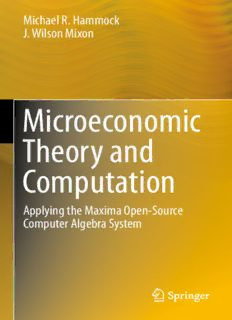Table Of ContentMichael R. Hammock
J. Wilson Mixon
Microeconomic
Theory and
Computation
Applying the Maxima Open-Source
Computer Algebra System
Microeconomic Theory and Computation
Michael R. Hammock • J. Wilson Mixon
Microeconomic Theory
and Computation
Applying the Maxima Open-Source
Computer Algebra System
123
MichaelR.Hammock J.WilsonMixon
DepartmentofEconomicsandFinance BerryCollege
MiddleTennesseeStateUniversity MountBerry,GA,USA
Murfreesboro,TN,USA
ISBN978-1-4614-9416-4 ISBN978-1-4614-9417-1(eBook)
DOI10.1007/978-1-4614-9417-1
SpringerNewYorkHeidelbergDordrechtLondon
LibraryofCongressControlNumber:2013954834
©SpringerScience+BusinessMedia New York 2013
Thisworkissubjecttocopyright.AllrightsarereservedbythePublisher,whetherthewholeorpartof
thematerialisconcerned,specificallytherightsoftranslation,reprinting,reuseofillustrations,recitation,
broadcasting,reproductiononmicrofilmsorinanyotherphysicalway,andtransmissionorinformation
storageandretrieval,electronicadaptation,computersoftware,orbysimilarordissimilarmethodology
nowknownorhereafterdeveloped.Exemptedfromthislegalreservationarebriefexcerptsinconnection
with reviews or scholarly analysis or material supplied specifically for the purpose of being entered
and executed on a computer system, for exclusive use by the purchaser of the work. Duplication of
this publication or parts thereof is permitted only under the provisions of the Copyright Law of the
Publisher’slocation,initscurrentversion,andpermissionforusemustalwaysbeobtainedfromSpringer.
PermissionsforusemaybeobtainedthroughRightsLinkattheCopyrightClearanceCenter.Violations
areliabletoprosecutionundertherespectiveCopyrightLaw.
Theuseofgeneraldescriptivenames,registerednames,trademarks,servicemarks,etc.inthispublication
doesnotimply,evenintheabsenceofaspecificstatement,thatsuchnamesareexemptfromtherelevant
protectivelawsandregulationsandthereforefreeforgeneraluse.
While the advice and information in this book are believed to be true and accurate at the date of
publication,neithertheauthorsnortheeditorsnorthepublishercanacceptanylegalresponsibilityfor
anyerrorsoromissionsthatmaybemade.Thepublishermakesnowarranty,expressorimplied,with
respecttothematerialcontainedherein.
Printedonacid-freepaper
SpringerispartofSpringerScience+BusinessMedia(www.springer.com)
ToShelby:Somevalueisbeyond
computation.
Preface
TheMaximacomputeralgebrasystemisanopen-sourcetoolforconductingmathe-
matical analysis using a computer. The analyst can use it to manipulate symbols,
to derive numerical computations, and to graph relationships. Also, it provides
a powerful programming language that allows the analyst to extend Maxima’s
capabilities to address specific questions. Maxima’s symbolic and computational
abilities allow one to go farther into a given problem and develop a deeper
understanding of microeconomic principles than would be possible without such
anaid.
ReviewingandExtendingTextbookAnalysis
This book shows how one can examine many of the economic relationships that
form the core of microeconomic theory using this computer algebra system. It
lets readers see how to set up the relevant analysis and how symbolic expres-
sions, numerical computations, and graphical representations can be derived and
combined. Once this knowledge is available, readers are in a position to extend
the analysis, either by changing selected parameter values or by making more
fundamental changes in the models. In particular, it facilitates comparative statics
analysis.
The material developed in this book provides readers a way to gain a deeper
understanding of a set of fundamental economics principles. It has two additional
goals:toprovideafoundationforreaderswhowillpursueadditionalcourseworkin
computationaleconomics,andtohelpreadersdeveloptheirabilitytouseacomputer
algebrasystemformoregeneralpurposes.
ComputationalEconomics
Students who advance to courses in computational economics will build on and
extendthematerialinthisbook.Theywillconsidertopicsthataremoreadvanced
vii
viii Preface
than, but directly related to, the ones developed here. Likewise, they will move to
powerfulapplicationsofMaximathatarebrieflyintroducedinthisbook,specifically
theuseofitspowerfulandflexibleprogramminglanguage.
Beyond coursework, many students will find that mathematical analysis is part
of their career. For these, Maxima can be an important part of their careers. It is
possible,however,thatinstitutionsinwhichtheyareemployeduseMathematicaor
otherproprietaryprograms.Inthesecases,familiaritywithMaximamakesmastery
oftheotherprogramsarelativelydirectmatter.
EngagedLearning
The paragraphs above refer to students and readers, but students/readers (you)
shouldbeactivelyengaged.Thewebsitehttp://www.wxmaximaecon.com/contains
a set of wxMaxima workbooks that allow recreation of all of the input and output
thatappearsinthebook.(wxMaximaistheuserinterfaceformMaximathatweuse
throughoutthisbook.)Youshouldopentherelevantfileandworkwithitasyouread
thesection.Thetextcontainsafewsuggestedexercises,butfurtherexperimentation
will yield rewards (and, occasionally, will be fun). You won’t break anything that
cannotbereplacedbyafreshdownload.
Also,donotbereluctanttogoallthewaybacktolookatChap.1whenworking
throughthematerialinlaterchapters.Chapter1explainsmanybasictechniquesthat
canbecomeconfusingwhenyouareworkingthroughadvancedexamples.Youmay
finditsurprisinglyhelpfultolookatthemagaininasimplercontext.
In addition to the workbooks that underpin the book, the web site contains
exercise sets that extend the material in the text, and it contains other applications
that do not relate directly to the text. Also, it contains links to sites that pertain
directly toMaxima. These sitesprovide theinformation required todownload and
installMaximaonyourcomputerandtipsonMaxima’suse.
ReaderswhoarealreadyfamiliarwithproprietarysoftwaresuchasMathematica
or Maple will see the similarities between these programs and Maxima. This
similarity points to another source of insights into using Maxima: books and web
sitesthatofferinstructionintheuseoftheseotherprograms.
KeytoTextbooks
Wehavetriedtomakethematerialself-containedbysketchingthetheoryonwhich
theMaximaapplicationsarebased.Spaceprecludesacompletedevelopmentofthe
theory, however, so we provide the following key to some microeconomic theory
textbooks.
The columns identify the textbooks that are listed below the table. The first
column,labeledHM,referstothisbook.Thus,eachrowidentifiesachapterinthis
book and the related chapter(s) in the other textbooks. Brackets below correspond
tothecolumnlabels.
Preface ix
HM BB BZ McA ML MWG NS P V1 V2
2 1,2 1,2 2 2,6 – 1,2 2.3 – 1
3 3 3 5 12 1 3 4 3 3,4
4 4 3 5 12 2 4 4 3 5
5 5 4 5 13 3 5,6 5 3 6–8,14
6 6 7 4 9 5 9 6 1 18–20
7 7 8 4 9 5 10 7 1 7
8 8 9 4 10 10 11 8 2 22–23
9 9 9 4 10 10 11 8 2 22–23
10 10 – – – 10 12 9 – –
11 16 – 5 14 – 13 10 5 31–32
12 11 11,13 6 15 12 14 11 2 25
13 12 12 – – – – 12 – –
14 13,14 13 7 17 12 15 13,14 2 27
15 – 17 4 11 20 17 16 – 10
BB BesankoD,BraeutigamR(2011)Microeconomics,4thedn.Wiley,NewYork
BZ Browning EK, Zupan MA (2011) Microeconomics: theory and applications, 11th
edn.Wiley,NewYork
McA McAfeeRP(2009)Introductiontoeconomicanalysis.Availableatwww.mcafee.cc/
Introecon/.Thenotesatthesiteindicatethedifferencesbetweenthistextandthe
nextone
ML McAfee RP, Lewis TR (2009) Introduction to economic analysis. Avail-
able at catalog.flatworldknowledge.com/catalog/editions/mcafee-introduction-to-
economic-analysis-1-0
MWG Mas-Colell A, Whinston MD, Green JR (2005) Microeconomic theory. Oxford
UniversityPress,NewYork
NS NicholsonW,SnyderC(2008)Microeconomictheory:basicprinciplesandexten-
sions,11thedn.South-Western,Mason
P PerloffJM(2012)Microeconomicswithcalculus,2ndedn.Addison-Wesley,Boston
V1 VarianHR(1992)Microeconomicanalysis,3rdedn.Norton,NewYork
V2 Varian HR (2009) Intermediate microeconomics: a modern approach, 8th edn.
Norton,NewYork
Murfreesboro,TN,USA MikeHammock
MountBerry,GA,USA J.WilsonMixon
Description:Economists can use computer algebra systems to manipulate symbolic models, derive numerical computations, and analyze empirical relationships among variables. Maxima is an open-source multi-platform computer algebra system that rivals proprietary software. Maxima’s symbolic and computational capab

